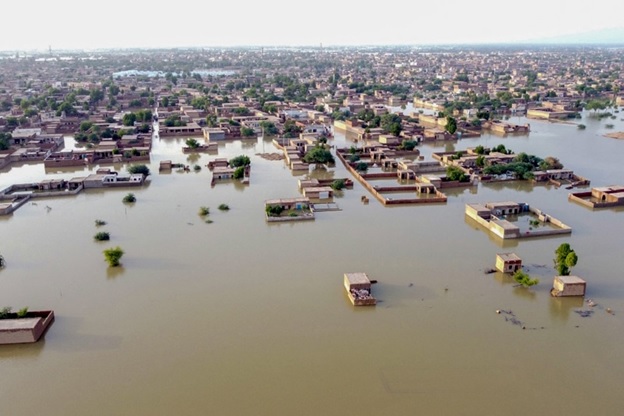
NewsSeptember 02 , 2022

Manila Standard
One-Third of Pakistan Is under Water, More than 1,100 Die as Rain Keeps on Coming
By Aspen Pflughoeft
Months of monsoon rains have caused massive flooding across Pakistan, affecting tens of millions of people and wreaking havoc on infrastructure.
Pakistan’s current monsoon season began mid-June and just entered its eighth week, the country’s minister of climate change, Sherry Rehman , told DW in an interview video she shared on Sunday, August 28. “Many districts are beginning to look like they’re part of the ocean,” she said.
The monsoon rains — coupled with melting glaciers — have caused “ unprecedented ” flooding in all four of the country’s provinces, CNN and The Guardian reported. Pakistan has more than 7,500 glaciers, the most of any non-polar region.
As a result, “ one-third of Pakistan is underwater,” Rehman told Sky News on Aug. 29.
The extent of the flood’s destruction is staggering. Pakistan’s National Disaster Management Authority released a monsoon situation report on Aug. 29 that said:
- Floods have killed 1,136 people and injured at least 1,634 more since June 14.
- More than 33 million Pakistanis have been affected.
- So far this year, Pakistan has received about 15 inches of rainfall compared with the historic year-to-date average of about 5 inches.
- Flood-damaged infrastructure includes more than 1 million houses either partially or fully destroyed, over 2,150 miles of road destroyed, 162 bridges gone and over 700,000 livestock lost.
At least 348 children are among those killed by the severe rains and flooding, CNN reported.
“This is a huge humanitarian disaster. And I would call it quite apocalyptic,” Rehman told Sky News.
“The sad part is that it is not stopping,” Rehman said to DW. “The rain is relentless. The water is coming down in buckets from a merciless sky.”
The country has declared a national emergency , deploying the army and — for the first time in its history — the navy to aid relief efforts, The Guardian reported and Rehman told DW. Still, many areas remain inaccessible to emergency responders, who cannot find dry places to drop badly needed supplies or land their helicopters, Rehman told Sky News.
A map of the monsoon floods from the United Nations Office for the Coordination of Humanitarian Affairs on August 26 showed damage across the country with the worst damage in the southern provinces of Balochistan and Sindh.
Human-induced climate change has amplified the intensity and duration of the extreme weather events happening in Pakistan, Rehman repeatedly explained. “This is very far from a normal monsoon – it is climate dystopia at our doorstep,” she said, per Al Jazeera.
“We are at ground zero of a climate dystopia,” she told Channel 4 News .
Photos showed the “dystopia” on the ground. In Hyderabad, the second-largest city in the Sindh province, people waded through knee-height water. In Balochistan, a man returned to his flood-hit home to try and salvage what he could.
People navigated through flooded roads after heavy monsoon rains, in Hyderabad, Pakistan.
Videos of the floodwater showed large buildings collapsing and washing away with shocking speed. Brown-tinged water ripped through residential areas, other footage showed.
Pakistan has urgently called for aid from the international community, Al Jazeera reported. – Miami Herald
Courtesy Miami Herald
Back to Pakistanlink Home